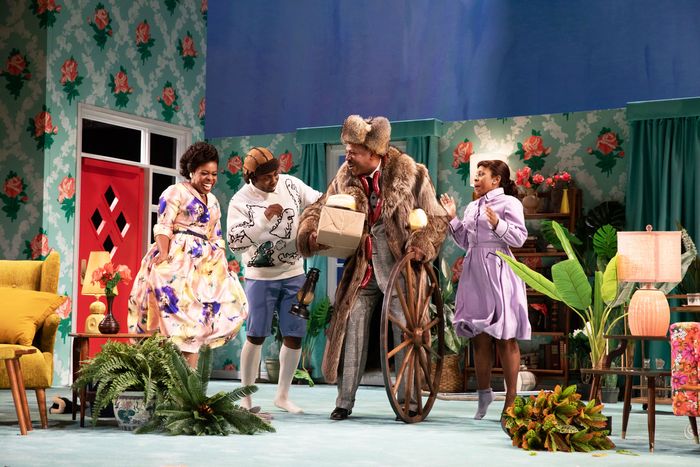
If the only thing you know about Thornton Wilder is his masterpiece Our Town, then his other Pulitzer Prize–winning play, The Skin of Our Teeth, is going to come as a shock. You will show up at Lincoln Center anticipating restrained aesthetics (will they have a ladder, or just mime one?) and the purity of a secular hymn. You might have even packed a hankie for the sad parts. And then — probably around the same time the 15-foot-tall dinosaur walks in — you’ll realize something’s up.
If Our Town is a hymn, The Skin of Our Teeth is a pie fight. Both an epic and a burlesque of epics, Skin is a comedy (in Dante’s sense) of humanity’s narrow escapes. It’s also ten kinds of mess, piled high with variously aging satires, dubious social commentary, piercing social commentary, prescience, digression, and despair. New York saw another revival of the 1942 play relatively recently, in 2017 at Brooklyn’s Theater for a New Audience, a production that responded to the election and climate change. It’s a difficult play and hard to produce, but it’s also the show you do when the world is ending.
The everyfamily the Antrobuses — dad is George (James Vincent Meredith), mom is Maggie (Roslyn Ruff) — live through all of humanity’s disasters, condensed. The first act takes place in the Ice Age: The Antrobuses are Flintstones-style mashups, simultaneously Father Knows Best–style sitcom suburbans and fire-obsessed Early Man. As the glaciers crawl south, refugees, a chilly mammoth, and that lifelike brontosaurus take shelter in their Excelsior, New Jersey, living room. In the second act, the show’s weakest, the Great Flood hits Atlantic City. The third act is war.
George and Maggie are the Eternal Couple, Adam and Eve–ish, parents to an undying daughter, Gladys (Paige Gilbert), and a perennially violent son, Henry (Julian Robertson). Their sometime maid, Sabina (the gifted Gabby Beans), has her eye on George, and Wilder infuses her with all of history’s marginal women — Sabina is the Bible’s disobedient Lilith, Helen of Troy, and an anonymous camp follower rolled into one. Wilder filters our understanding of the drama through her: Sabina talks directly to us, narrating at first but then complaining, refusing to say her lines, and finally, capitulating to the play.
When he wrote it, Wilder’s meta-theatrical satire was knife-edge stuff: He was chopping up his own contemporary culture, burning the trash (mass media’s fatuousness and guff) to light up the treasure (quotes from Spinoza and Homer). In the few years since 1938’s Our Town, his attitude toward the word our had clearly changed from warm inclusion to collective blame. In this text, those humans who escape by the skin of their teeth are the ones who shove the beasts out into the killing ice, who push others away from the ark. Survivors are not usually the good guys. This play’s “our” is one that points to everyone in the theater. If you’ve gotten this far, it asks, whom did you hurt?
The director Lileana Blain-Cruz has cast the Antrobuses as a Black family, so playwright Branden Jacobs-Jenkins makes some necessary, feather-light adjustments to the text. A racist murder in the second act is no longer racist, for instance, and in the third act, in the procession of the thinkers, Jacobs-Jenkins has added bell hooks to the roster. Conceptually, I’m on board. Experientially, though, the thing is a roller coaster, and I don’t mean the light-up one that designer Adam Rigg has placed on a New Jersey boardwalk. Blain-Cruz meets Wilder’s maximalism with her own, his gravity with her seriousness, but the writer’s comedy and the director’s don’t coincide. Beans in particular gets caught in the gap. She is being asked to play Sabina’s broad stuff so broadly — in the ill-shaped Vivian Beaumont, which tends to swallow up every gesture — that we only realize what a glittering star she is when she drops the act for one of her many asides.
Blain-Cruz is best when things get tableau-y; she’s a jewel-cutter, not a choreographer, as we have learned in gorgeous productions including Fefu and Her Friends. She’s foiled by big ensemble-movement scenes (there are more than two dozen people in the cast), and she and sound designer Palmer Hefferan occasionally let the sonic atmosphere of the show get muddy. The second act is unbearably confused; it collapses into noisy (as opposed to biblical) chaos. Yet Blain-Cruz’s deft touch with language arias and images is still unsurpassed. In that tricky second act, projection designer Hannah Wasileski puts a sky behind the set that’s so perfect it looks like a moving painting. When the superb Ruff delivers a thundering radio address about women, the clouds seem to stop to listen.
We’re not what books and plays say we are. We’re not what commercials and advertisements say we are. We’re not in the movies and we’re not on the radio. We’re not what you’re all told and what you think we are: We’re ourselves.
And if any man can find one of us he’ll learn why the whole universe was set in motion.
And if any man harm any of us, his soul — the only soul he’s got — had better be at the bottom of that ocean.
Chills, I tell you, chills down my arms.
Hang on for that third section, too, when all the collaborators, living and dead, mesh their gears perfectly together. When the show was in rehearsals, Wilder had reenlisted in the Army Air Force; he couldn’t be there because he was already back in the service. Skin therefore isn’t about a specific conflict so much as it is about the cycle of mass violence, the unendingness of it, its inescapability and waste. Wilder lets his satire down long enough for you to see how clinging to the writers of the past has given him, ultimately, cold comfort. (When Robert Woodruff directed Skin in the ’90s, the books George saved from the war crumble in his hands. Blain-Cruz’s production isn’t quite so cynical, but the books, with which George plans to build a new civilization, do look suspiciously … crispy.) Rigg’s final set is also a world-beating beauty: a huge, dark, grassy bank covered in wildflowers. Figures move through it dressed in their uniforms, a host of Civil War dead walking through the rye.
And, really, the third act is the whole reason to go. (Well, that and designer James Ortiz’s sweet puppet brontosaurus.) Wilder’s comedy has gotten damp in places, but his tragedy is still dry and highly explosive. In this section, Blain-Cruz takes the show by the scruff and shakes it hard, and as Yi Zhao’s lights go dim, we see Beans, Ruff, Robertson, and Meredith giving staggering performances. In the dark and quiet, the rest of the world leaks in. Images from the war in Ukraine, horrors you remember from the news, all flicker against your mental screen, making every word doubly painful. Just one line from Mrs. Antrobus — “There are no dogs left in Excelsior” — left me breathless. The night I saw the show, some of the audience didn’t have the patience to stay; we lost a swath of folks at the second intermission after that rocky, interminable middle section. If only there had been some way to tell them to wait! But then that’s the world for you. Nobody ever believes that things will work out in the end.
The Skin of Our Teeth is at the Vivian Beaumont Theater at Lincoln Center.





